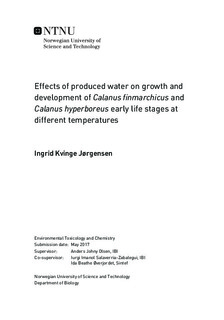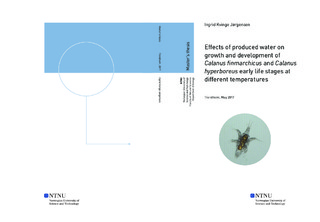| dc.description.abstract | The temperature in the Arctic is increasing, which causes the sea ice to retreat. This opens for more offshore activity and longer shipping season for transportation vessels. The Arctic region is thought to contain large recoverable petroleum resources. Produced water (PW) is the main part of the waste water released from the platform during offshore activity. Polycyclic aromatic hydrocarbons (PAHs), present in produced water, has been shown to cause negative effects on growth, development and survival of aquatic organisms. The boreal species Calanus finmarchicus and the arctic species C. glacialis and C. hyperboreus are important constituents of the North Atlantic and Arctic food webs, and are essential prey species for fish larvae, in addition to juvenile and adults of smaller fish species. The early life stages of these species may be sensitive to produced water components. To examine this, the egg-stage of the two species C. hyperboreus and C. finmarchicus were exposed to the water-soluble fraction (WSF) of 11 selected PAHs at three different concentrations (100%: 1.80-13.23 μg L-1, 50%: 1.08-6.33 μg L-1, 10%: 0.38-1.22 μg L-1) in addition to a control. They were reared at three different temperatures (C. hyperboreus: 3, 7.5, and 10°C, C. finmarchicus: 7.5, 10, and 12.5°C), to examine if the expected increase in temperature in the Arctic may cause additional effects. Hatching percentage was after PAH exposure of eggs at the different temperatures. From the egg-stage to the first feeding stage (NIII), biometry and dry weight) were analyzed. In addition, their ability to feed was measured at the NIII-stage, after 6 and 20 hours of algae exposure. Generally, the copepods developed faster with increasing temperature. Temperature seemed to have a larger impact on the development time and hatching of the eggs, than exposure. For dry weight the effects of both temperature and exposure remained inconclusive, with few significant differences within the different developmental stages, for both species. Considering the biometry, both temperature and exposure seemed to have some impact on the length of the nauplii. C. hyperboreus NII and NIII was longer at 7.5°C, compared with 3°C. However, NIII at 10°C was shorter than at 3°C. Therefore, higher temperature seems to be stimulating growth up to a point, however, beyond point, the effect is negative. For C. finmarchicus, some effects were seen of both temperature and exposure, however, they did not seem to be very large. No significant effects were seen on C. finmarchicus with regard to temperature and exposure on their ability to feed. However, it seems that the combination of high temperature (10°C) and PAH-exposure may have a negative impact on C. hyperboreus ability to feed, after 20 hours. | |

